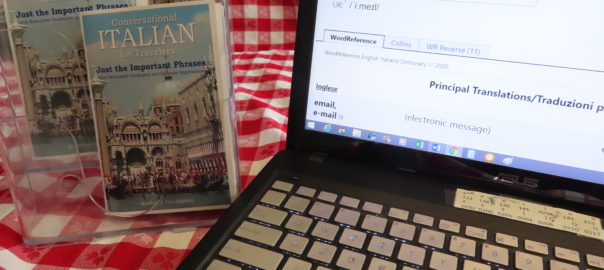Italian Subjunctive (Part 6): Situations for Italian Adjective Clauses and Comparisons
 Read here about Italian adjective clauses and Italian comparison phrases and learn about important situations that use the Italian Subjunctive Mood!
Read here about Italian adjective clauses and Italian comparison phrases and learn about important situations that use the Italian Subjunctive Mood!
Can you speak Italian? By now, many of you have passed the beginning stages of learning to speak Italian and can read and comprehend quite a bit of the Italian language. Meraviglioso!
But have you tried to take the next step to speak Italian fluently? Do you know which situations use the Italian subjunctive mood? To express complex feelings in Italian correctly, it is important to use the Italian subjunctive mood. Using the subjunctive mood is difficult for English speakers, as we only rarely use this tense in English, and this is something that I am always working on! The next two blogs in the “Speak Italian” blog series will focus on how to use the Italian subjunctive mood, or “il congiuntivo.”
Let’s take that giant step from simple beginning sentences to more complex and fluid sentences in Italian by using the subjunctive mood. In this segment, we will discuss Italian adjective clauses that take the subjunctive mood, and also include a brief discussion of comparison phrases and when Italian comparison phrases require the subjunctive mood. Finally, we will learn how to use the conjunction “sia” as a conjunction in order to connect phrases when trying to say, “Both…and…” Example sentences will follow using Italian adjective clauses for each situation.
In each blog in the “Speak Italian” series about the Italian subjunctive mood (“il congiuntivo”), we will first present situations take the Italian subjunctive mood.
In this blog, we will then present common Italian adjective clauses used in daily life that take the Italian subjunctive mood.
Remember these examples as “anchors” in your knowledge for when you must speak Italian and try out the subjunctive mood in your next Italian conversation!
Enjoy our blog: “Italian Subjunctive (Part 6): Situations for Italian Adjective Clauses and Comparisons”
—Kathryn Occhipinti
Some of this material is adapted from our textbook, Conversational Italian for Travelers © 2012 by Stella Lucente, LLC, found on www.learntravelitalian.com. Special thanks to Italian instructor Maria Vanessa Colapinto.
A Brief Review of Phrases that take
the Italian Subjunctive Mood
In previous blogs, we have noted that Italian uses a subjunctive mood that to express beliefs, thoughts, or hopes with the verbs credere, pensare, and sperare.
The subjunctive mood is also said to “open up” a conversation to discussion about a particular topic by expressing doubt, uncertainty, desire, or a feeling.
Certain phrases are commonly used to start a sentence in order to introduce the subjunctive mood, and these initial phrases can be in the indicative tense (the “usual” present or past tense) or in the conditional tense. These initial phrases imply uncertainty and require the subjunctive mood.
These groups are listed below.
Groups 1-9: “Noun Clauses”
Group 10: “Adverbial Clauses”
Groups 11 and 12: “Adjective Clauses, Indefinite Antecedents, Negative Antecedents”
-
-
- Phrases that use the verbs credere (to believe), pensare (to think), and sperare (to hope). These verbs use the pattern: [verb + di + infinitive verb] to describe the beliefs, thoughts, or hopes that one has. When the subject in the introductory phrase is not the same as the subject in the subjunctive clause that follows, the pattern changes to: [verb + che + subjunctive verb].*
- Impersonal constructions that begin with, “It is…” such as, “È possibile che…”
- Phrases that express a doubt, such as, “I don’t know…” or “Non so che…”
- Phrases that express suspicion, such as, ” I suspect that…” or “Sospetto che…”
- Phrases that express uncertainty, such as, “It seems to me…” or “Mi sembra che…” and ” To wonder if…” or “Chiedersi se… “
- Impersonal verbs followed by the conjunction che, such as, “Basta che…” “It is enough that,” or “Si dice che…” “They say that…
- Phrases that use the verbs volere, desiderare, chiedere, esigere when the subject in the introductory phrase is not the same as the subject in the clause that follows. In this situation, these verbs will be followed by che.
- Phrases that use the verbs piacere and dispiacere when the subject in the introductory phrase is not the same as the subject in the clause that follows. In this situation, these verbs will be followed by che.
- Phrases that express feelings (any emotion, fear, surprise) and use the pattern: [avere, essere, or augurarsi verb + di + infinitive verb]. When the subject in the introductory phrase is not the same as the subject in the clause that follows, the pattern changes to: [avere, essere, or augurarsi verb + che + subjunctive verb].
- Sentences that begin with words that end in –ché, or complex conjunctions that end with che: affinché, perché (so as, so that, in order that), purché (as long as, provided that, only if)**, a meno che, senza che (unless), può darsi che (it may be possible that, possibly, maybe), prima che (before that). Also the many words that mean although/even though, one of which ends in -che: benché (also sebenne, malgrado, nonostante).***
- Sentences that begin with the idea of any in a description of a person, place or thing: qualsiasi, qualunque (any), chiunque (whoever), dovunque (anywhere).
- Sentences that begin with the idea of nothing or only in a description of a person, place, or thing: niente che, nulla che (nothing that), nessuno che (nobody that), l’unico, il solo, a che (the only one that).
- Phrases that correspond to the English “both… and…” use the conjunction sia and the structure “sia… che…”
- Hypothetical Phrases: Phrases that begin with se (if) in certain situations. Phrases that begin with come se (as if), magari (if only), ammesso che (assuming that).
For a review of how to use the groups of phrases that need the Italian subjunctive mood listed above, please see our previous blogs on this topic by clicking on the links below:
How to Use the Present Tense Italian Subjunctive Mood (Parts 1-3).
How to Use the Imperfetto Subjunctive for Italian Past Tense (Parts 1-3)
How to Use The Italian Subjunctive Mood (Parts 4 and 5) — Hypothetical Phrases
You will notice that numbers 11 and 12 above discuss specific phrases called adjective clauses that take the subjunctive mood. In this blog, we will discuss various situations, along with specific words and phrases, that will trigger the subjunctive mood in the adjective clause.
We will also discuss number 13 as the last section in this bog in order to learn how to express “both… and…” and “whether… or…” in Italian, including when it is necessary to use the subjunctive mood with these phrases.
************************************************
Points to remember about the subjunctive mood:
In Italian, the introductory phrases that take the subjunctive mood (those that trigger doubt, uncertainty, desire, or a feeling) usually end with a linking word, also known as a conjunction, which will be che. In this situation, che means that. The clause that follows our introductory phrase will then describe what the uncertainty is about.
We now see from Group 9 that some words or phrases already have -ché or che integrated into the word itself. In these cases, che is not repeated. The clause that follows our introductory phrase will then describe what the uncertainty is about.
*When the speaker in the introductory phrase will carry out the action in the phrase to follow, Italian will use the following construction to link the phrases for credere, pensare, and sperare : di + infinitive verb. Example: Penso di andare a Roma domani. = I think I will go to Rome tomorrow. (Use pensare a when thinking ABOUT something or someone.)
**solo se also means only if but does NOT take the subjunctive mode.
*** anche se also means even though/if but does NOT take the subjunctive mode.
************************************************
Finally, a word of caution:
DO NOT USE THE SUBJUNCTIVE WITH THE FOLLOWING THREE PHRASES!
Forse = Perhaps
Per me = For me
Secondo me = According to me
Solo se = Only if
Anche se = Even though, If
The above may seem like exceptions to the rule, but perhaps… because these phrases already express doubt or your personal opinion… in the Italian way of thinking, it would be redundant to use these phrases along with the subjunctive!
An adjective clause is a phrase that modifies a noun or a pronoun. Simply stated, an adjective clause is a group of words that together add additional information or further describe the person, place, or thing a sentence is about. These phrases are dependent clauses, as they cannot stand alone as a complete sentence but are dependent on the phrase that comes before them to make sense.
Now that we know what an adjective clause is, we have to discuss which adjective clauses require the Italian subjunctive mood. Italian adjective clauses are commonly used in speech and writing, and of course, not all will need the subjunctive mood!
In short, when modifying a comparison or an uncertain situations with an adjective clause, will need a subjunctive mood verb in the adjective clause.
Similar to other situations when it is necessary to use the Italian subjunctive mood, when modifying an Italian phrase by adding an adjective clause after it, the two phrases must be linked by a conjunction, which will be che. In this situation, che means who or that.
Read on below to find out which comparative or uncertain situations will need to take the Italian subjunctive mood to make a more complex and varied sentence when speaking Italian.
************************************************
Italian Adjective Clauses that Modify
Indefinite Antecedents:
“Cercare”
Many situations arise when an individual will mention a specific thing or person they are looking for, but at the time of the conversation the speaker knows that this specific desire may only exist in his or her imagination. This type of situation is called an “indefinite antecedent.”
We often talk about our desires in conversation, and love to elaborate on exactly what we want , even though we know that what we want may not actually exist. When using an adjective clause, one does not outright state they are making a wish; instead, what they desire, and the uncertainty that they will find it, is inherent in their statement.
The most common situations of this type is when someone is looking for a particular thing or a person. In Italian, the verb “to look for” is cercare.
When a sentence starts with a particular wish of this type, the thing one is looking for can be elaborated upon, even if its actual existence has yet to be proven. When describing this thing with an adjective clause, it is necessary to use the subjunctive mood.
If one is looking for a person, and that person is unaware of this activity, or maybe even does not exist, here again is a case for using the subjunctive mood!
You will notice from the examples below that in English we use the simple present tense in these situations.
Il mio amico cerca un appartamento che abbia due camere da letto.
My friend is looking for an apartment that has two bedrooms.
Sto cercando una fidanzata che sia intelligente e simpatica.
I am looking for a girlfriend who is intelligent and nice.
************************************************
Italian Adjective Clauses that Modify
Indefinite Antecedents:
“Any”
The Italian subjunctive mode must be used with adjectives or pronouns that include the idea of any in a description of a person, place or thing, such as qualsiasi, qualunque (any), chiunque (whoever), dovunque (anywhere). These words are listed under #11 above. Here, again, there is some uncertainty as to the person, place, or thing, as the speaker is making a generalization, rather than pointing out someone or something specific. The subjunctive mood is used directly after these words.
Of note: qualcuno, which can mean: “anyone, anybody, someone, somebody” is not included in this list!
There are many, many situations in which one might use the above words to express the idea of “any.”* Some examples are listed below. How many more can you think of?
Mi va bene qualsiasi posto che sia vicino al finestrino per favore.
Any place that is near the window is good for me, please.
Chiunque possa imparare un’altra lingua deve essere molto intelligente.
Anyone who can learn another language must be very intelligent.
Dovunque io vada in Italia è tutto bellissimo!
Anywhere I go in Italy is all very beautiful!
************************************************
Italian Adjective Clauses that Modify
Negative Antecedents:
If the speaker in a conversation is wishing for someone or something specific, but already knows he or she will not be able to find it, the sentence will begin with “non” to create an antecedent in the negative form. Interrogative antecedents (when questioning something) can also fall into the negative antecedent category. We have already mentioned different negative antecedents briefly in #12 of the list in our first section.
The Italian verb that is used in the adjective clause to follow the negative antecedent describe this “nobody” (nessuno) or “nothing” (niente/nulla) that we wish exists, but know does not. Since we are talking about a wish or desire that does not exist, our adjective clause will need be in the subjunctive form.
Notice in the examples below that English uses the simple present tense for the dependent adjective clause.
Non c’è nessuno a questa festa che io conosca bene.
There is no one at this party that I know well.
Non c’è niente che io voglia comprare in questo negozio.
There is nothing that I want in this store.
Non c’è nulla che tu voglia comprare in questo negozio?
Is there nothing in this store that you want to buy?
A Brief Review of
How to Make Comparisons in Italian
Before we can learn when to use the Italian subjunctive mood in comparative sentences, we must first learn how comparative sentences are structured in Italian. The material for this section has been provided by the Conversational Italian for Travelers textbook and the Conversational Italian for Travelers “Just the Grammar” books, found on the website www.Learntravelitaliancom and Amazon.com.
**************************************
Comparison of Different Characteristics
of the Subject in Italian
When comparing different characteristics of the subject in a sentence, where one characteristic is better or worse than the other, use the following phrases below. This pattern works for comparisons with adjectives, adverbs, and infinitive verbs.
Comparison of Different Characteristics of the Subject in Italian
| più… che |
more… than |
| meno… che |
less… than |
La casa è più grande che bella. The house is more large than beautiful.
Caterina ha meno amici che parenti. Kathy has fewer friends than relatives.
Mi piace di più studiare che lavorare. I like studying more than working.
*************************************
Comparison of Different Nouns in Italian
In order to compare two different nouns, i.e. people, places or things, where one has a superior or inferior characteristic, use the following phrases below. Note that di will combine with the definite article (il, la, lo, or l’) as usual if the definite article is needed in the sentence.
Comparison of Two Different Nouns in Italian
| più…. di |
more… than |
| meno… di |
less… than |
La casa di Pietro è più grande Peter’s house is larger than Kathy’s
della casa di Caterina. house.
Pietro ha più soldi di Caterina. Peter has more money than Kathy.
Caterina ha meno soldi di Pietro. Kathy has less money than Peter.
Questo vestito è più elegante del tuo vestito.
This dress is more elegant than your dress.
*************************************
Grammar Note – Relative Superlatives
Optional Use of the Subjunctive Mood
Relative superlatives are descriptions that refer to the most or the least, and are often rendered in English with the ending -est. In Italian, the equivalent to the most is il più or la più, for masculine and feminine nouns respectively. The equivalent to the least is il meno or la meno. The relative superlatives always precede the adjective they modify.
When the adjective to be modified comes before the noun, the relative superlative phrases are used with the definite article, as given above. If the adjective to be modified comes after the noun, the definite article (il, la) is omitted from the relative superlative phrase. In the second case, the definite article will already be in front of the noun for proper grammar! See the examples below for how this works.
Also, notice that instead of the word in, Italians use di with comparisons, which is often combined with the definite article (il, la, lo, etc.). Refer to Conversational Italian for Travelers “Just the Grammar” if you need to learn more about how to combine definite articles with prepositions.
Milano è la più bella città d’Italia. Milan is the most beautiful city in Italy.
– or –
Milano è la città più bella d’Italia. Milan is the city (which is) the most
beautiful in Italy.
Caterina è la meno alta della famiglia. Kathy is the least tall in the family.
Pietro è il più alto della famiglia. Peter is the tallest in the family.
When modifying a relative comparison sentence with an adjective clause,
the subjunctive mood is optional.
*************************************
Grammar Note – Absolute Superlatives
The absolute superlative ending translates into very or really/extremely, and is used to say that something is simply the best, even beyond comparison. The ending used to make an adjective into the absolute superlative is -issimo. Remember from Chapter 6 how molto bene and benissimo both translated into very well/really well?
The absolute superlative ending will change to reflect the gender and number of the adjective modified, from –issimo to: -issima, -issimi,or -issime. The last vowel of the adjective is dropped before adding these endings; buono will become buonissimo, grande will become grandissimo, and bella will become bellissima.
Il caffè in Italia è buonissimo. The coffee in Italy is really good.
I palazzi a Milano sono grandissimi. The buildings in Milan are extremely big.
Milano è una bellissima città. Milan is a very beautiful city.
Le fontane sono bellissime. The fountains are really beautiful.
Italian Adjective Clauses that Modify
Absolute Superlatives
Now that we have reviewed how to make comparisons in Italian, we are ready to discuss how to use absolute superlative phrases with the Italian subjunctive mood. In short, if you describe a person, place, or thing, and then want to say that this is “the best” you have ever seen, heard, met, etc. you must use the subjunctive!
For the speaker, at the point in time of the conversation, this is the best he or she has experienced; although one might say there is always the possibility that this opinion could change in the future. Someone or something else may come along that is even better! And, where there is uncertainty, we need to use the subjunctive mood!
Some examples follow. Notice the use of the word “mai” to mean “ever,” which reinforces the idea of “the most.”
Since the speaker is talking about what they have experienced, the subjunctive verb conjugation must also be in the past. In this examples below the form used is the passato congiuntivo.
The last example has been structured as a question, since we often ask others about their best experiences to date!
La Sicilia è l’isola più bella che io abbia mai visto.
Sicily is the most beautiful island that I have ever seen.
Mia madre è la donna più brava che io abbia mai incontrato.
My mother is the most wonderful woman that I have ever met.
Questa è la più bella sinfonia che io abbia mai sentito.
This is the most beautiful symphony that I have ever heard.
È questa la più bella sinfonia che tu abbia mai sentito?
Is this the most beautiful symphony that you have ever heard?
*************************************
Italian Adjective Clauses that Modify
Equivalents to Absolute Superlatives:
“Unico, Solo, Primo, Ultimo”
There are single Italian adjectives that can be considered to be “equivalent” to the absolute superlatives. We have listed some above in the first section under Number 12 as the words which mean “only”: unico, solo, a che uno. To these words we add primo, which means “first” and “ultimo,” which means “last.”
When using the above Italian adjectives as absolute superlatives, their endings must agree in gender and number to the noun they modify (the same as for all Italian adjectives). The placement of the adjective will be between the definite article (il, la, lo, l’, etc.) and the noun it modifies. Notice that these adjectives can be plural, since sometimes a group of things may be involved in the statement.
Check out the singular and plural forms of these absolute superlative adjectives below. You will remember from beginning Italian that the ending of the adjective primo changes since it is a cardinal number, and primo has regular endings. The adjectives solo and ultimo also have regular endings.
The adjective ultimo has an irregular in pronunciation in the plural masculine form (gli unici) and an irregular in spelling to preserve the pronunciation in the plural feminine form (le uniche).
| l’unico |
l’unica |
gli unici |
le uniche |
| il solo |
la sola |
i soli |
le sole |
| il primo |
la prima |
i primi |
le prime |
| l’ultimo |
l’ultima |
gli ultimi |
le ultime |
Some example sentences using unico, solo, primo, and ultimo are given below. These words can be used in many different situations to make complex, descriptive sentences. How many more can you think of?
Lui è l’unico ragazzo che mi piaccia nel mio paese.
He is the only boy that I like in my town.
Questa casa è l’unica casa che io abbia visto dipinta tutto in giallo.
This house is the only house that I have seen painted all in yellow.
Quella soluzione è solamente la prima soluzione che dobbiamo considerare.
This solution is only the first solution that we must consider.
L’Ultima Cena è l’ultimo quadro che Leonardo da Vinci abbia dipinto con la tempera.
The Last Supper is the last painting that Leonardo da Vinci painted with tempera (egg-based paint).
How to Use
the Italian Conjunction
“Sia… che…” to say “Both.. and…”
To finish our blog on adjective phrases, we now mention a way to link two nouns or verbs within a single descriptive phrase — use the Italian word sia as a conjunction!
By now, we have become used to using the word “sia” as the present tense singular subjunctive form of essere, as we’ve learned way back in the first blog on this topic. But we now mention that the Italian word sia can also be used as a conjunction , which is a simple linking word.
In effect, Italian word sia does double duty as both a verb and a conjunction!
In sentences where one wants to express both… and…, in effect linking two equal alternatives to one another in one phrase, the first alternative is introduced with the conjunction sia and the second alternative follows after the word che. In this case the word “che” is translated into English with the word “and.”
In some instances, this idea may also be communicated by using the conjunction sia twice, with the phrase sia… sia…. It is more common in spoken Italian to hear sia…che…, although in a very few sentences you might hear sia…sia…, which is perfectly correct too.
One sentence where the sia… sia… combination is used frequently refers to films that are adapted to two specific groups of people, young and old: “Il film è adatto sia a un pubblico adulto sia a un pubblico giovane.”
*************************************
How to Make Phrases with
“Sia… che…” to say “Both.. and…”
To form a phrase with the Italian conjunction sia is easy. When we would say, “both… and..” in English, just substitute “sia… che…” in Italian. A noun can be linked with a noun or a verb can be linked with a verb to show that there are two separate but equal possibilities for a single situation. Just use the sia… che combination!
Remember to use the Italian definite article with each noun that follows the conjugation sia, as is usual for Italian nouns. The exception will be when using the Italian preposition “in” to go into a country, region or state, or large island like Sicily, as is usual for situations of this type.
Remember to use the infinitive form of the Italian verb that follows the conjugation sia, and conjugate only the main verb in the sentence.
The dependent phrase with sia…che… can be used as the subject of the sentence itself, especially when two people are the subject. In this case, the verb is conjugated in the third person plural form. If this is confusing, just substitute “they” for the subject!
But, above all…
Don’t fall into the trap of translating the English
words “both” and “and” directly into Italian.
Instead, use “sia… che…”!
For instance:
Mi piace parlare sia l’italiano che l’inglese.
I like to speak both (the) Italian and (the) English (languages).
Mi piace viaggiare sia in Italia che in America.
I like traveling, both in Italy and in America.
Io devo sia comprare che incartare il regalo prima di andare al lavoro stasera.
I have to both buy and wrap the gift before going to work tonight.
Sia Marco che Maria (Loro) mi hanno invitato alla festa di compleanno di Julia.
Both Mark and Mary (They) have invited me to Julia’s birthday party.

Kathryn Occhipinti, MD, is the author of the
Conversational Italian for Travelers series of books and a teacher of Italian for travelers to Italy in the Peoria and Chicago area.
“Everything you need to know to enjoy your visit to Italy!”
Join my Conversational Italian! Facebook group and follow me on Twitter at StellaLucente@travelitalian1 and start to learn Italian today for FREE!
Conversational Italian! Facebook Group
Tweet @travelitalian1 for Stella Lucente Italian
YouTube videos to learn Italian are available from © Stella Lucente, LLC.
Learn Conversational Italian.
More information on and photographs of Italy can be found on Facebook Stella Lucente Italian and Pinterest Stella Lucente Italian.
Facebook Stella Lucente Italian
Pinterest Stella Lucente Italian
Visit learntravelitalian.com/download.html to purchase/download Conversational Italian for Travelers and find more interesting facts and helpful hints about getting around Italy! Learn how to buy train tickets online, how to make international and local telephone calls, and how to decipher Italian coffee names and restaurant menus, all while gaining the basic understanding of Italian that you will need to know to communicate easily and effectively while in Italy. —From Stella Lucente, LLC
Italian Subjunctive (Part 6): Situations for Italian Adjective Clauses and Comparisons
Speak Italian like a native when you use the Italian verb “Prendere”!









